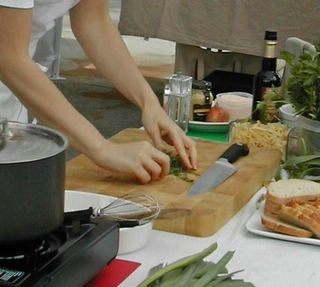Thursday, March 17, 2005
Spicy Mango Pickle
Last month I traveled around England with sweet Colin to observe him in his native habitat. The trip was outstanding and full of many wonderful surprises, including the staggering changes in the quality of the food since my last extended stay, which was early in the 90’s. I am happy to report that eating out almost everywhere we went, was a true pleasure. (The fanatsic company only adding to the experience.) The one thing that hadn’t changed of course was the outrageously good Indian food. The one fully Indian meal we had (in the Acocks Green suburb of Birmingham, of all places) was best I had had in ages.
Naturally, this lead me to attempt to decipher what is Southern Indian versus Northern, Bengali versus Punjabi food and many, many other questions. With a little research I learned (ha ha!) that there is much more to Indian cuisine than my little mind can absorb. (Flash back to a college course on World Philosophies that ended up being 90% about Hinduism because it is so complex, leaving very little time to cover any others.)
Since the Indian subcontinent is larger in mass than Europe (excluding Russia), has always been a cultural crossroads and has culinary restrictions based on religious and cultural demands, it is a very tricky area to boil down to a few interesting culinary tidbits. What I did learn is that Indian cuisine is truly as diverse as it's people and geography. Since you are most likely not here to read a dissertation on the subtle (and not so subtle) differences in regional cuisine, I will distill what I have learned to this: There are seven major culinary regions, (within 25 States) Bengali, Punjabi, Goan, Gujarati, Kashmiri, Marathi and South Indian and 14 recognized “schools” of cooking. (And to think, my only Indian cuisine cookbook is spectacular, but strictly vegetarian Lord Krisna’s Cuisine. Imagine all the great dishes I have been missing!) Obviously that is just the tip of the iceberg, since
In the interest of keeping this short (oh wait, too late) I will focus on three (large) regions: Southern, Eastern and Northwestern, since these are most commonly represented in Western restaurants. I realize this is terribly simplified, and am sorry about that, but want to keep this short enough that you will keep reading. For much more information, I recommend a visit to India Foods Online. I will revisit this topic in the future as I do love Indian food, and somehow think it is important to grasp the complexities.
-- The Northwestern province of Punjab is home to what most Westerners are served as Indian food. Though a tiny region, their influence has been great. Dishes include Tandoori Chicken, Naan, Alu Tikki, Chapatti and Parathas (stuffed chapatti), the preferred cooking oil is ghee (a clarified butter) which is used along with a lot of other dairy products, including lassi (the buttermilk drink) paneer (cheese) and yogurt.
-- Food from the South would be more towards what we would call tropical, including tamarind, coconut milk and grated coconut as a garnish, breads made of dal, (lentils), and most importantly fish. This is the region where coffee is grown too. Basmati rice is the staple food for the people of South India instead of wheat, which is more popular in the North. This region is primarily vegetarian, so meat dishes will be rare, if found at all.
-- In Eastern Indian (Bengali) cuisine, fish again is a staple food, and the main cooking oil is mustard oil. Though actually Northeastern, Bengali’s eat rice. This region is also home to many of the most famous Indian sweets.
I hope that helps just a little bit in your understanding, it certainly inspired me!
Phew. Now, here is my recipe for kasu mango. It is basically a spicy mango pickle. In Los Angeles I am able to buy mango vathal (cured and salted mango slices) and asafoetida at any number of stores. If you cannot, just use a super ripe mango and substitute turmeric for the asafoetida. The results are sweet and sour and puckery and hot. Serve this with rice and dal (cooked lentils) and enjoy!
1 cup mango vathal
4 teaspoons mustard oil (or, if you cant find that, use vegetable or peanut oil)
1/3 cup, yellow or black mustard seeds
3 tablespoons, red chili powder (not the mix for Chile Con Carne. Just pure chiles ground to powder)
1/2 teaspoon fenugreek powder
1/2 teaspoon asafoetida powder
Boiling water
Pour 1/4 cup boiling water over the mango vathal and soak for 1/2 hour. In a large sauce pan heat 1 teaspoon of the oil over high heat then add mustard seeds. When the mustard seeds begin to pop, add the fenugreek powder, asafoetida, chili powder and the remaining oil. Heat through (about 1 minute) then add the mango pieces and stir. Let cook for about 2 minutes, then remove from the heat. Allow to cool, then store, covered, in the refrigerator for up to a week.
Makes about 1 1/2 cups
___________________________________________________________
Chicken tikka masala is the all time most popular dish in Indian restaurants
Vindaloo is a dish of Portuguese origin that was created when they colonized Goa
Balti is a style of cooking. The word balti translates to "bucket"
Rogan Josh is part of the 24 course Kashmiri banquet known as a Wazan
There are 24 Zagat rated Indian restaurants in the greater L.A. area
Driving for 30 minutes around town, I counted 17 (only two of which were in Zagats)
My favorite North Indian restaurant is Nawab of India in Santa Monica
pride for helping to restore the reputation of British cuisine!
<< Home
<< Home


